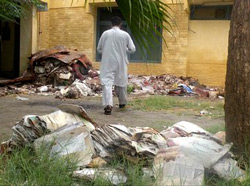The 2010 flooding in Pakistan killed many people, wiped out 1.5 million homes and caused 10 billion in direct and indirect losses. However, it also destroyed records – many of them of genealogical importance. Following is a teaser from an article in the July 29, 2011 edition of the BBC News.
The River Kabul, which cuts through the middle of the town [Nowshera], overflowed its banks on both sides on the evening of 29 July 2010, inundating the entire town.
Nearly a dozen people were killed, and hundreds of homes wiped out completely.
The entire population of the town – some 100,000 people – had to relocate to relief camps or move in with friends and relatives in nearby villages.
The district administration, the police and the local judiciary took between four to six months to get back into their stride, and hiccups still persist.
The rains this year are not as relentless, but there is a constant trickle as we step into the offices of the district land administration, called Tehsil.
We are looking for Mr Iqbal’s “lost evidence.”
Locals are desperate to stop “land grabbers” stealing their inheritance.
What we find is heaps of muddied bundles of decomposed paper and cloth piled high in two dingy rooms, both full of cobwebs and, warns one official, scorpions and snakes.
Some bundles are scattered in the lawns and corridors of the premises, all dried into cakes of paper pulp mixed with mud.
These were once files of land sketches and genealogical trees of the landowners of about 160 villages of Nowshera district, the oldest of them dating from 1870.
